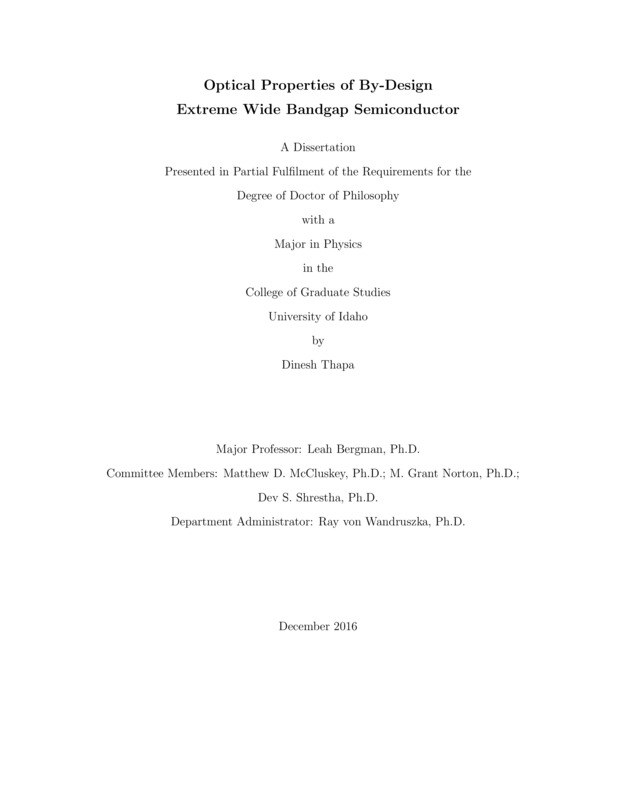Optical Properties of By-Design Extreme Wide Bandgap Semiconductor
Thapa, Dinesh. (2016). Optical Properties of By-Design Extreme Wide Bandgap Semiconductor. Theses and Dissertations Collection, University of Idaho Library Digital Collections. https://www.lib.uidaho.edu/digital/etd/items/thapa_idaho_0089e_11060.html
- Title:
- Optical Properties of By-Design Extreme Wide Bandgap Semiconductor
- Author:
- Thapa, Dinesh
- Date:
- 2016
- Embargo Remove Date:
- 2018-12-20
- Program:
- Physics
- Subject Category:
- Physics
- Abstract:
-
Alloying has the potential to create new types of semiconductors with novel optical properties that can be tailored to a specific application by the choice of the composition. ZnO and MgO in particular can be used to create the ternary MgxZn1-xO alloy system. In the alloy formula, x is the composition that spans the values 0 to 1. The two end members ZnO and MgO both have bandgaps in the UV range: ZnO at ~ 3.4 eV (364.7 nm) and MgO at ~7.5 eV (165.3 nm). Thus, depending on the composition x and the solubility limits, alloys with bandgaps between 3.4 eV and 7.5 eV can be achieved. These types of alloys are very useful in UV technologies.
One of the desirable features of the MgxZn1-xO alloys is that the constituents ZnO and MgO are relatively environmentally friendly materials. Moreover, owing to the deep excitonic binding energies of ZnO and MgO and to their direct bandgaps, MgxZn1-xO is an attractive alloy system for the creation of luminescent materials with by-design wavelengths. However, a key obstacle to the realization of viable semiconductor alloys lies in the optimization of their optical properties in a manner that overcomes the impact of various types of defects. In this research, MgxZn1-xO alloy films over a wide range of Mg composition were synthesized via sputtering, and the optical and material properties of the films were explored utilizing several analytical techniques.
Main results of this research are: Post growth annealing in Ar atmosphere ~900C was found to enhance significantly the desirable UV luminescence. Specifically, for ZnO the enhanced UV luminescence correlated well with the elimination of native defects and improved film’s morphology. In the case of MgxZn1 xO alloys, the enhanced UV luminescence was found to be related to the reduction of alloy inhomogenity as well as improvement of films’s morphology. Moreover, as this alloy system has inherent phase segregation, it is important to consider the composition range where structural segregation occurs. We utilized XRD and selective resonance Raman scattering (SRRS) to study this issue. It is shown that SRRS is highly sensitive optical technique to detect the structural inhomogeneity in the MgxZn1-xO alloys.
- Description:
- doctoral, Ph.D., Physics -- University of Idaho - College of Graduate Studies, 2016
- Major Professor:
- Bergman, Leah
- Committee:
- McCluskey, Matthew D.; Norton, M. Grant; Shrestha, Dev S.
- Defense Date:
- 2016
- Identifier:
- Thapa_idaho_0089E_11060
- Type:
- Text
- Format Original:
- Format:
- application/pdf
- Rights:
- In Copyright - Educational Use Permitted. For more information, please contact University of Idaho Library Special Collections and Archives Department at libspec@uidaho.edu.
- Standardized Rights:
- http://rightsstatements.org/vocab/InC-EDU/1.0/

